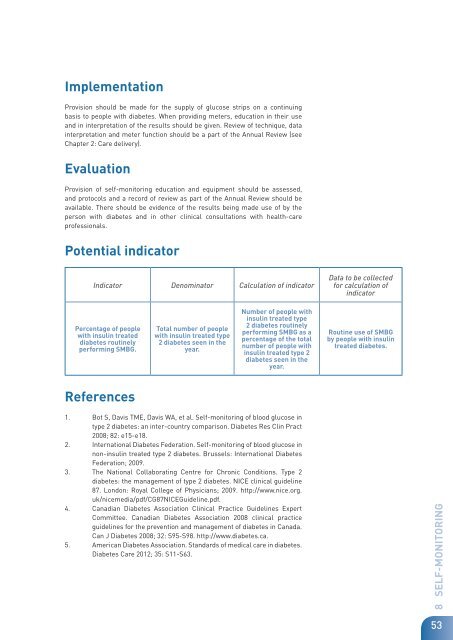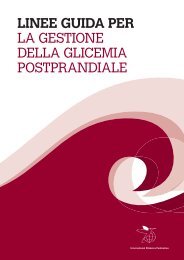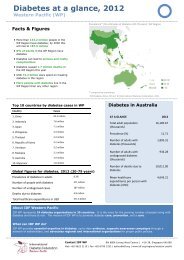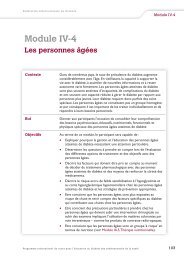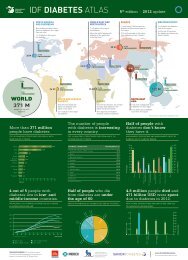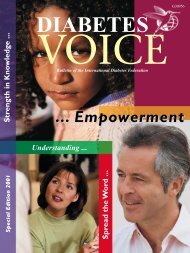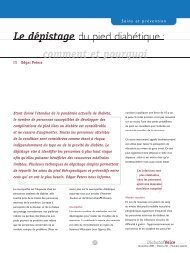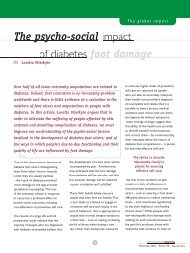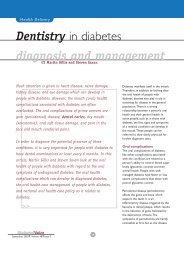Evidence-base - International Diabetes Federation
Evidence-base - International Diabetes Federation
Evidence-base - International Diabetes Federation
Create successful ePaper yourself
Turn your PDF publications into a flip-book with our unique Google optimized e-Paper software.
Implementation<br />
Provision should be made for the supply of glucose strips on a continuing<br />
basis to people with diabetes. When providing meters, education in their use<br />
and in interpretation of the results should be given. Review of technique, data<br />
interpretation and meter function should be a part of the Annual Review (see<br />
Chapter 2: Care delivery).<br />
Evaluation<br />
Provision of self-monitoring education and equipment should be assessed,<br />
and protocols and a record of review as part of the Annual Review should be<br />
available. There should be evidence of the results being made use of by the<br />
person with diabetes and in other clinical consultations with health-care<br />
professionals.<br />
Potential indicator<br />
Indicator Denominator Calculation of indicator<br />
Percentage of people<br />
with insulin treated<br />
diabetes routinely<br />
performing SMBG.<br />
References<br />
Total number of people<br />
with insulin treated type<br />
2 diabetes seen in the<br />
year.<br />
Number of people with<br />
insulin treated type<br />
2 diabetes routinely<br />
performing SMBG as a<br />
percentage of the total<br />
number of people with<br />
insulin treated type 2<br />
diabetes seen in the<br />
year.<br />
1. Bot S, Davis TME, Davis WA, et al. Self-monitoring of blood glucose in<br />
type 2 diabetes: an inter-country comparison. <strong>Diabetes</strong> Res Clin Pract<br />
2008; 82: e15-e18.<br />
2. <strong>International</strong> <strong>Diabetes</strong> <strong>Federation</strong>. Self-monitoring of blood glucose in<br />
non-insulin treated type 2 diabetes. Brussels: <strong>International</strong> <strong>Diabetes</strong><br />
<strong>Federation</strong>; 2009.<br />
3. The National Collaborating Centre for Chronic Conditions. Type 2<br />
diabetes: the management of type 2 diabetes. NICE clinical guideline<br />
87. London: Royal College of Physicians; 2009. http://www.nice.org.<br />
uk/nicemedia/pdf/CG87NICEGuideline.pdf.<br />
4. Canadian <strong>Diabetes</strong> Association Clinical Practice Guidelines Expert<br />
Committee. Canadian <strong>Diabetes</strong> Association 2008 clinical practice<br />
guidelines for the prevention and management of diabetes in Canada.<br />
Can J <strong>Diabetes</strong> 2008; 32: S95-S98. http://www.diabetes.ca.<br />
5. American <strong>Diabetes</strong> Association. Standards of medical care in diabetes.<br />
<strong>Diabetes</strong> Care 2012; 35: S11-S63.<br />
Data to be collected<br />
for calculation of<br />
indicator<br />
Routine use of SMBG<br />
by people with insulin<br />
treated diabetes.<br />
8 SELF-MONITORING<br />
53


